Whales of Southeast Alaska
Photo Tour 2009 Trip Report
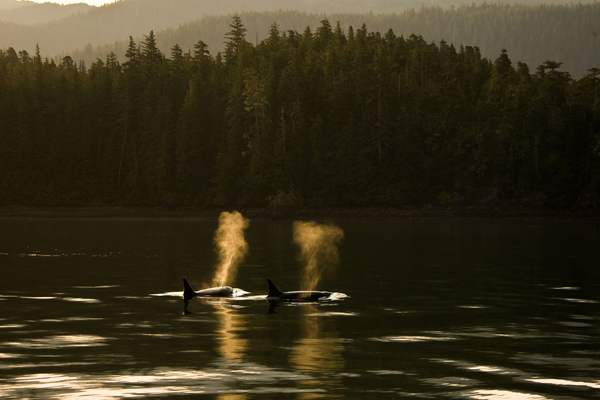
Wildlife viewing and photography is usually a quiet affair of hushed voices, whispers, cautious gestures, and slow movements. Perhaps it is the grand scale of the scene, the Alaskan Inside Passage, or the larger than life spectacle of our subjects, humpback whales and orcas. For what ever reason, the normal protocol of wildlife viewing is tossed aside as one is virtually compelled to shout or to scream out exclamations of awe and excitement when a great whale materializes like a streaming missile from quiet waters, rising high, flippers waving, before flopping, backwards, with a resounding crack and enormous splash back into the sea. Welcome, to whale watching!
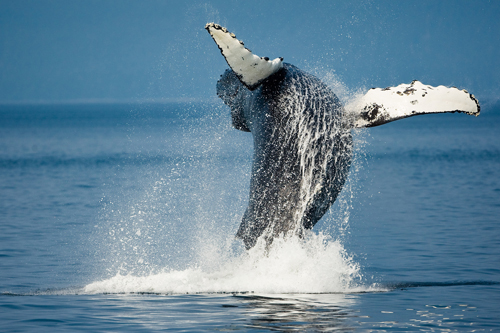
It has been about six years since our last whale photography trip to southeastern Alaska, and I approached this trip with mixed feelings. I was extremely excited to finally photograph whales on digital where the previous constraints of budget, both in the cost of film and the quantity one carried, would no longer apply. Digital, too, would be quite helpful for our shutter speeds or depth of field, in the marginal light that we might experience if we'd have rain. Conversely, though, I remember enduring long hours of inactivity on our previous trips and I wondered if our time might be better spent elsewhere.
With these conflicting expectations we began what proved to be the BEST WHALE PHOTOGRAPHY TRIP we've ever had. More than that, the trip was so unexpectedly successful, so filled with activity and diversity, and so much more exciting and rewarding than anticipated that I suspect it will be one of our favorite trips of the entire year. That might seem like an unrealistic claim but as you'll see, it was simply fantastic. See our Participants' Portfolio for a selection of the Best Shots of the entire trip, and our portfolio web gallery.
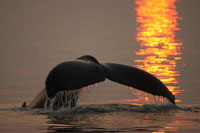 As I write this I worry that readers might accuse me of hyperbole, of exaggeration for effect, but the shooting was so good, and the crew of our boat so wonderful, that superlatives are simply in order. When I say people scream or shout with delight I'm not exaggerating. To experience a 60 foot whale blasting from the sea in front of you, to witness a glacier calve the equivalent of a city's block of apartments in a wall of crashing ice, to photograph all of these and more -- black bears, bald eagles, Steller's sea lions, sea otters, orcas, all at frame-filling distances, superlatives, then, are definitely in order, and at that perhaps an understatement.
As I write this I worry that readers might accuse me of hyperbole, of exaggeration for effect, but the shooting was so good, and the crew of our boat so wonderful, that superlatives are simply in order. When I say people scream or shout with delight I'm not exaggerating. To experience a 60 foot whale blasting from the sea in front of you, to witness a glacier calve the equivalent of a city's block of apartments in a wall of crashing ice, to photograph all of these and more -- black bears, bald eagles, Steller's sea lions, sea otters, orcas, all at frame-filling distances, superlatives, then, are definitely in order, and at that perhaps an understatement.
Trip Highlights
In truth there were so many.
Perhaps the activity we most hoped to film was the bubble-net feeding of humpback whales. We'd seen it before but our shooting, back in film days, was only marginally successful and we hoped to blast away with our digital cameras.
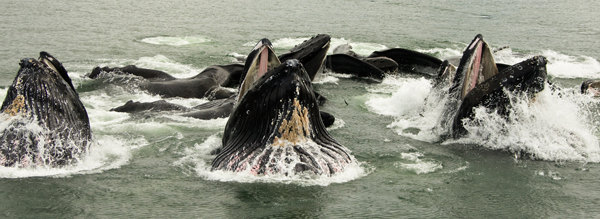
Humpback's bubble net feed by descending beneath a school of herring and, while circling the school from below, releasing a stream of bubbles that ascend, creating a circular wall that corrals the fish inside. The whales follow the bubbles to the surface where, seconds before they erupt from the sea, the surface shimmers with scores or hundreds of herring leaping in the air. An instant later, the sea erupts as a dozen or so humpbacks surface, mouth agape as they scoop up the wrangled herring.
As the whales fished, our captain, Dennis Rogers, suspended a hydrophone (underwater microphone) beneath the boat. Humpbacks are famous for their calls -- some version of the Song of the Humpback Whales has been a CD available for years -- and as they feed humpbacks emit a distinctive call, a nearly continuous, haunting hum, an 'ahhhhhh ahhhhhh ahhhhhh' wailing that rises to a crescendo as they rise beneath their bubble net to capture the herring.
Whales breaking the surface are nearly undistinguishable, their familiar whale shape so distorted that, in photos, its difficult for an uninformed observer to recognize the parts. The whale's lower jaw drops nearly flat, creating a vast table-like net while the upper jaw juts upward, slicing the sky. The scene is confused by the jaws and flukes of other whales, creating at times a chaotic scene that lasts only a few seconds. Sometimes the whales rose with some space between them where every head gaped distinctly, and the bullfrog-like throat pouch bulged hugely and grotesquely. The throat, in bulging, draws in a huge vacuum into which water and fish are sucked, before the expanded pleats contract, forcing water through the baleen and out their mouths, capturing the herring in the countless rows of hair-like baleen.

All of this activity can occur anywhere, and the excitement, anticipation, and light stress combine to a fine focus of alertness as we watched for clues the whales were about to surface. If the whales were close by we could see the bubbles breaking the surface, a few at first that could be a false alarm and then a curved line that gradually ended in a circle. Distant whales were spotted, when we were lucky, by the gulls that circled overhead looking for an easy by-catch, and literally seconds before the whales surfaced the gulls would stoop low to catch the jumping fish. On several occasions the whales surfaced right next to the boat, so close that we literally looked into the yawning maws of these gigantic creatures (see our Participants' Portfolio for an incredible close up of this!)
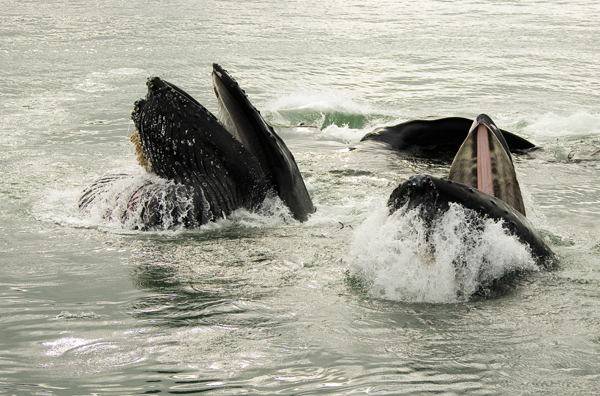
Incredibly, we captured wonderful bubble-net feeding on the afternoon and evening of our very first day on our boat! The next day the whales were still in the bay and we spent virtually the entire time following and shooting whales. We had numerous opportunities, but even with that we could have continued doing so for several more days. The shooting was intoxicating and addictive, but on our third morning the whales had vanished.
As we headed out to sea towards our next destination, a fluid term since our itinerary was dictated by the encounters and shooting opportunites that arose, we spotted two orcas, or killer whales. Their presence may have accounted for the absence of the humpbacks, but regardless, we followed these, the largest of the dolphins, as they patrolled the shoreline.
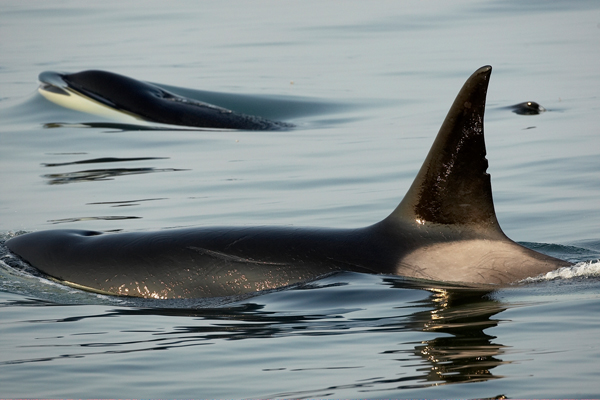
Dennis did an incredible job of positioning us for great back-lighting and front lighting, and for nearly an hour we followed along, sometimes with the whales so close that they more than filled the frame.
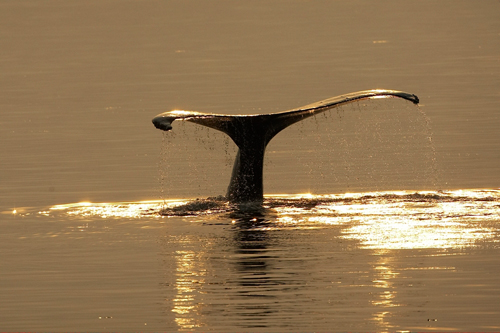 Later that afternoon, in a sea as still as a meadow pond, we were surrounded by over an hundred humpbacks, scattered in every direction. One breached, close, and Rich caught it, while I was stupidly looking at my camera's LCD monitor, chimping, and acting about as smart as a monkey! Towards evening we filmed innumerable whale tails as humpbacks sounded, silhouetting their huge tail flukes against an orange sun enhanced by the smoke of distant Yukon forest fires.
Later that afternoon, in a sea as still as a meadow pond, we were surrounded by over an hundred humpbacks, scattered in every direction. One breached, close, and Rich caught it, while I was stupidly looking at my camera's LCD monitor, chimping, and acting about as smart as a monkey! Towards evening we filmed innumerable whale tails as humpbacks sounded, silhouetting their huge tail flukes against an orange sun enhanced by the smoke of distant Yukon forest fires.

Everyone had hoped to see bubble-net feeding, but truly one of the most spectacular sights in nature must be a breaching humpback whale. This, as my opening comments alluded to, literally compels one to exclaim with excitement and awe. Sometimes the breach was anticipated, as a whale slapped the water repeatedly with a front flipper, doing a pectoral slap that resembled idle play, before sounding and, a minute or two later, blasting skyward from the sea.

Even more exciting were the occasions when the sea would erupt with a breaching whale completely unexpectedly, a streaming mass of white water and dark, hulking whale rocketing skyward in a whoosh of water, cresting, twisting, and smacking against the sea in a resounding, gunshot-like report that could be heard for miles, sending a wall of water rising in a V-shaped arching wall dozens of feet into the air.
 One evening, while Tom was showing me an image on his computer I looked beyond his shoulder where, through the window, a whale had suddenly appeared, rising in a veil of white that resolved itself into a whale that literally corkscrewed a 270 degree turn before smashing into the sea. Mary, still shooting, caught the shot full-frame with a 500mm lens. Me, well I just hollered a resounding expletive as my mind registered an image I still see in my mind's eye.
One evening, while Tom was showing me an image on his computer I looked beyond his shoulder where, through the window, a whale had suddenly appeared, rising in a veil of white that resolved itself into a whale that literally corkscrewed a 270 degree turn before smashing into the sea. Mary, still shooting, caught the shot full-frame with a 500mm lens. Me, well I just hollered a resounding expletive as my mind registered an image I still see in my mind's eye.
After a nearly full day of photographing breaching whales we headed to the little fishing village of Kake where we'd refill our fresh water supplies, Dennis would go for a much needed jog, and our group would photograph black bears at the Gunnar creek salmon hatchery, if we were lucky.
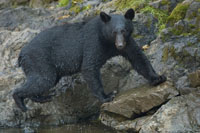
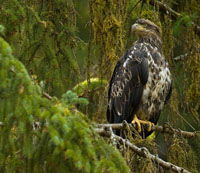
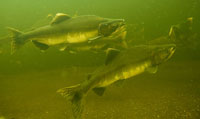
Mary and I had been to Kake on our previous trips and found it beautifully quaint but a bit boring. No bears, no eagles, just a day on land. Things were different on this trip, as a viewing platform had been erected at the creek. Two or three very habituated black bears showed up while we were there, in addition to a couple of immature bald eagles that perched obligingly quite close to the stream, giving nearly frame-filling shots.
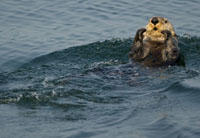 As we sailed into Kake we encountered a large group of resting sea otters on a kelp bed. Normally, Dennis explained, the otters are fairly tolerant and after a momentary dispersal the otters will return and investigate the boat. These otters were shy, although we stayed a considerable distance away, but as we drifted along with the sea we passed one that was completely unconcerned. It groomed its incredibly luxurient fur and rolled like a spinner in the gentle seas, giving us frame-filling shots that were, once again, the best we'd ever had on an Alaskan cruise.
As we sailed into Kake we encountered a large group of resting sea otters on a kelp bed. Normally, Dennis explained, the otters are fairly tolerant and after a momentary dispersal the otters will return and investigate the boat. These otters were shy, although we stayed a considerable distance away, but as we drifted along with the sea we passed one that was completely unconcerned. It groomed its incredibly luxurient fur and rolled like a spinner in the gentle seas, giving us frame-filling shots that were, once again, the best we'd ever had on an Alaskan cruise.
In speaking with two hatchery employees in Kake, Mary discovered that there was a viewing window for the salmon, and from there we had superb underwater views of silver salmon and large trout passing by. With our G10s pressed against the glass we shot video, and with our 16mm lenses set likewise we shot stills, catching great shots. It was an unexpected highlight and opportunity that, on the next trip, I know we'll spend a lot more time. Unfortunately most of the group had hiked back down the road for eagles by the time we discovered the fish window, but those that left did shoot a couple of adult eagles perched close enough for decent shots.
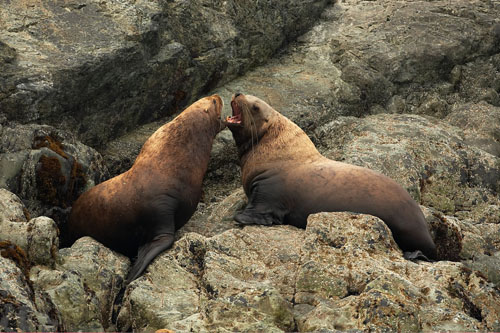
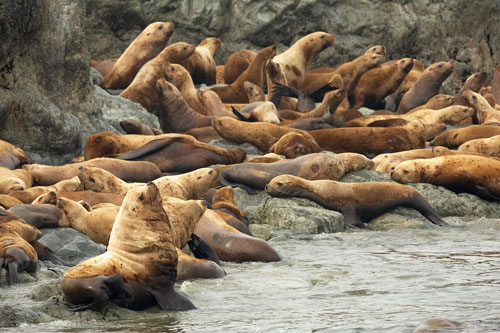
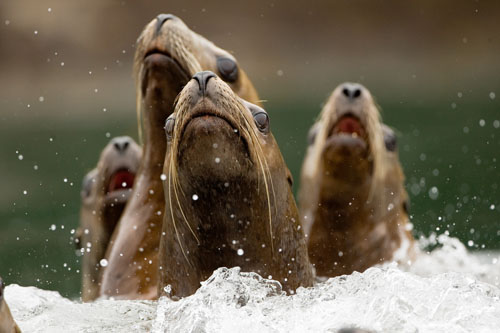
On almost all of our coastal Alaska trips we've seen or photographed Steller's sea lions, on our whale trips and also on our bear trips, but Dennis took us to a seal haul out on a remote island where we had, quite simply, the best sea lion photography we've had anywhere. As Dennis predicted, the seals eventually grew curious and approached our boat, bobbing up and down in the water at headshot, frame-filling distances. Mary recorded audio as seals growled and chirped at the hydrophone, and everyone blasted away, especially when a dozen or so sea lions lined up to bark asynchronically but continually, as if they were begging for food.
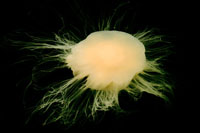 That afternoon we had one of our most surprising highlights as we sailed into a quiet, little visited bay to photograph lion's mane jellyfish and moon jellyfish as they pulsated by in the clear, blue-black water. I doubt if any one of us expected this particular shoot to be as rewarding as it turned out to be, and that shoot ended up with several participants including the jellyfish shots as their most treasured from the trip!
That afternoon we had one of our most surprising highlights as we sailed into a quiet, little visited bay to photograph lion's mane jellyfish and moon jellyfish as they pulsated by in the clear, blue-black water. I doubt if any one of us expected this particular shoot to be as rewarding as it turned out to be, and that shoot ended up with several participants including the jellyfish shots as their most treasured from the trip!
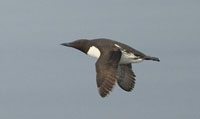
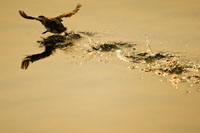
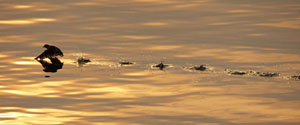
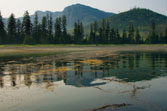
En route, between all of the highlights discussed above, we had other shooting opportunities, including moody or simply pretty images of the coast and coast lines of Fredrick Sound, the islands, mountain peaks, kelp beds and more. Birds were often around the whales and although the little murrelets were small, they produced intriguing patterns as they pattered across the mirror-like seas we so often had as they gained speed to get air borne, and several of us captured 'pick up shots' of murres, guillemots, gulls, and eagles as the opportunites arose.
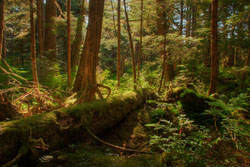 Our final morning was spent at Le Conte glacier where we sailed for several hours photographing strikingly beautiful glacial icebergs marooned on a shallow sand bar or floating by as we sailed to and from the glacier front. There we were treated by the very best iceberg calving spectacle we've ever had, anywhere, when, after several smaller bergs had calved, the anchoring ice of a 300 foot ice spire disintegrated before us, freeing the spire which then teetered and crashed into the bay. It was a truly incredible sight, and generated an enoromous wave that rocked our boat and sent the kitchen into chaos.
Our final morning was spent at Le Conte glacier where we sailed for several hours photographing strikingly beautiful glacial icebergs marooned on a shallow sand bar or floating by as we sailed to and from the glacier front. There we were treated by the very best iceberg calving spectacle we've ever had, anywhere, when, after several smaller bergs had calved, the anchoring ice of a 300 foot ice spire disintegrated before us, freeing the spire which then teetered and crashed into the bay. It was a truly incredible sight, and generated an enoromous wave that rocked our boat and sent the kitchen into chaos.
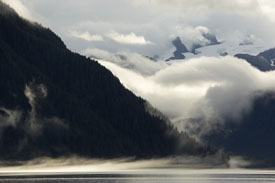

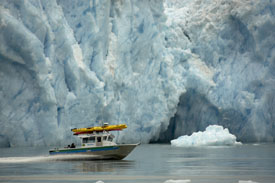
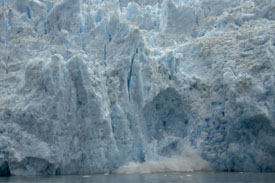
At the LeConte glacier, and the bay leading into it, the scenic potential was incredible. While we were at the glacier face a small boat, with tourists, decided to race along the ice wall at a frighteningly close distance. They motored fast, presumeably to lessen the chances of being at the wall should an iceberg calve. Another boat followed minutes later, and both boats then cruised out of sight. Just a few minutes later a 300 foot tall wall of ice broke free from the glacier and crashed into the bay, right where the boats had been! Had they been just a few minutes later, or the glacier's calving a few minutes earlier, a real disaster would have occured. Had the ice not crushed them the monsterous wave would have flipped them. They were lucky, and stupid! As we concluded the shoot it began to rain and continued doing so until we neared Petersburg where, as luck had played throughout the trip, the skies cleared as we unloaded and hauled our luggage and cameras off the dock.
Our brochure advertised the trip as a Photo Tour and Photoshop workshop, and although the weather cooperated with us, and downloading and editing images conspired against us, we still had some time on several evenings to review various Photoshop techniques. Doing so was difficult -- no one wanted to sit in a class when whales were about, and, in the evening, everyone was excited to look at their images. Nonetheless, we did accomplish some great things in PS, including Masking and using layers, making selections, and doing some workflow. My friend Tom is an expert in Adobe Lightroom, and he helped several folks with workflow issues using this program, and I, and I'm sure our other participants, thank him heartily for his help.
 As I write this I have but one worry -- can we fit another trip in next year? Our schedule was set for a 2011 trip but this one was so exciting, with innumerable images still awaiting us, that I simply can't wait to return!
As I write this I have but one worry -- can we fit another trip in next year? Our schedule was set for a 2011 trip but this one was so exciting, with innumerable images still awaiting us, that I simply can't wait to return!
If you are interested in this trip I'd urge you to contact our office IMMEDIATELY. We only take six participants with us so space is extremely limited, and three of the six from this year will probably go again!
It is quite likely that our next trip will be filled based upon this document and that we won't be writing a new brochure. You can refer to our old brochure (which I'll update with prices and dates as soon as they are set), but by the time I do that the trip may be full. So, if you are interested, please contact us immediately!
For an even better idea of the diversity of shooting we had, and how great that photography was, check out our Participants' Portfolio and also our personal portfolio (Joe and Mary's).
Whales of Southeast Alaska
Photo Tour 2009 Trip Report

Wildlife viewing and photography is usually a quiet affair of hushed voices, whispers, cautious gestures, and slow movements. Perhaps it is the grand scale of the scene, the Alaskan Inside Passage, or the larger than life spectacle of our subjects, humpback whales and orcas. For what ever reason, the normal protocol of wildlife viewing is tossed aside as one is virtually compelled to shout or to scream out exclamations of awe and excitement when a great whale materializes like a streaming missile from quiet waters, rising high, flippers waving, before flopping, backwards, with a resounding crack and enormous splash back into the sea. Welcome, to whale watching!

It has been about six years since our last whale photography trip to southeastern Alaska, and I approached this trip with mixed feelings. I was extremely excited to finally photograph whales on digital where the previous constraints of budget, both in the cost of film and the quantity one carried, would no longer apply. Digital, too, would be quite helpful for our shutter speeds or depth of field, in the marginal light that we might experience if we'd have rain. Conversely, though, I remember enduring long hours of inactivity on our previous trips and I wondered if our time might be better spent elsewhere.
With these conflicting expectations we began what proved to be the BEST WHALE PHOTOGRAPHY TRIP we've ever had. More than that, the trip was so unexpectedly successful, so filled with activity and diversity, and so much more exciting and rewarding than anticipated that I suspect it will be one of our favorite trips of the entire year. That might seem like an unrealistic claim but as you'll see, it was simply fantastic. See our Participants' Portfolio for a selection of the Best Shots of the entire trip, and our portfolio web gallery.
 As I write this I worry that readers might accuse me of hyperbole, of exaggeration for effect, but the shooting was so good, and the crew of our boat so wonderful, that superlatives are simply in order. When I say people scream or shout with delight I'm not exaggerating. To experience a 60 foot whale blasting from the sea in front of you, to witness a glacier calve the equivalent of a city's block of apartments in a wall of crashing ice, to photograph all of these and more -- black bears, bald eagles, Steller's sea lions, sea otters, orcas, all at frame-filling distances, superlatives, then, are definitely in order, and at that perhaps an understatement.
As I write this I worry that readers might accuse me of hyperbole, of exaggeration for effect, but the shooting was so good, and the crew of our boat so wonderful, that superlatives are simply in order. When I say people scream or shout with delight I'm not exaggerating. To experience a 60 foot whale blasting from the sea in front of you, to witness a glacier calve the equivalent of a city's block of apartments in a wall of crashing ice, to photograph all of these and more -- black bears, bald eagles, Steller's sea lions, sea otters, orcas, all at frame-filling distances, superlatives, then, are definitely in order, and at that perhaps an understatement.
Trip Highlights
In truth there were so many.
Perhaps the activity we most hoped to film was the bubble-net feeding of humpback whales. We'd seen it before but our shooting, back in film days, was only marginally successful and we hoped to blast away with our digital cameras.

Humpback's bubble net feed by descending beneath a school of herring and, while circling the school from below, releasing a stream of bubbles that ascend, creating a circular wall that corrals the fish inside. The whales follow the bubbles to the surface where, seconds before they erupt from the sea, the surface shimmers with scores or hundreds of herring leaping in the air. An instant later, the sea erupts as a dozen or so humpbacks surface, mouth agape as they scoop up the wrangled herring.
As the whales fished, our captain, Dennis Rogers, suspended a hydrophone (underwater microphone) beneath the boat. Humpbacks are famous for their calls -- some version of the Song of the Humpback Whales has been a CD available for years -- and as they feed humpbacks emit a distinctive call, a nearly continuous, haunting hum, an 'ahhhhhh ahhhhhh ahhhhhh' wailing that rises to a crescendo as they rise beneath their bubble net to capture the herring.
Whales breaking the surface are nearly undistinguishable, their familiar whale shape so distorted that, in photos, its difficult for an uninformed observer to recognize the parts. The whale's lower jaw drops nearly flat, creating a vast table-like net while the upper jaw juts upward, slicing the sky. The scene is confused by the jaws and flukes of other whales, creating at times a chaotic scene that lasts only a few seconds. Sometimes the whales rose with some space between them where every head gaped distinctly, and the bullfrog-like throat pouch bulged hugely and grotesquely. The throat, in bulging, draws in a huge vacuum into which water and fish are sucked, before the expanded pleats contract, forcing water through the baleen and out their mouths, capturing the herring in the countless rows of hair-like baleen.

All of this activity can occur anywhere, and the excitement, anticipation, and light stress combine to a fine focus of alertness as we watched for clues the whales were about to surface. If the whales were close by we could see the bubbles breaking the surface, a few at first that could be a false alarm and then a curved line that gradually ended in a circle. Distant whales were spotted, when we were lucky, by the gulls that circled overhead looking for an easy by-catch, and literally seconds before the whales surfaced the gulls would stoop low to catch the jumping fish. On several occasions the whales surfaced right next to the boat, so close that we literally looked into the yawning maws of these gigantic creatures (see our Participants' Portfolio for an incredible close up of this!)

Incredibly, we captured wonderful bubble-net feeding on the afternoon and evening of our very first day on our boat! The next day the whales were still in the bay and we spent virtually the entire time following and shooting whales. We had numerous opportunities, but even with that we could have continued doing so for several more days. The shooting was intoxicating and addictive, but on our third morning the whales had vanished.
As we headed out to sea towards our next destination, a fluid term since our itinerary was dictated by the encounters and shooting opportunites that arose, we spotted two orcas, or killer whales. Their presence may have accounted for the absence of the humpbacks, but regardless, we followed these, the largest of the dolphins, as they patrolled the shoreline.

Dennis did an incredible job of positioning us for great back-lighting and front lighting, and for nearly an hour we followed along, sometimes with the whales so close that they more than filled the frame.
 Later that afternoon, in a sea as still as a meadow pond, we were surrounded by over an hundred humpbacks, scattered in every direction. One breached, close, and Rich caught it, while I was stupidly looking at my camera's LCD monitor, chimping, and acting about as smart as a monkey! Towards evening we filmed innumerable whale tails as humpbacks sounded, silhouetting their huge tail flukes against an orange sun enhanced by the smoke of distant Yukon forest fires.
Later that afternoon, in a sea as still as a meadow pond, we were surrounded by over an hundred humpbacks, scattered in every direction. One breached, close, and Rich caught it, while I was stupidly looking at my camera's LCD monitor, chimping, and acting about as smart as a monkey! Towards evening we filmed innumerable whale tails as humpbacks sounded, silhouetting their huge tail flukes against an orange sun enhanced by the smoke of distant Yukon forest fires.

Everyone had hoped to see bubble-net feeding, but truly one of the most spectacular sights in nature must be a breaching humpback whale. This, as my opening comments alluded to, literally compels one to exclaim with excitement and awe. Sometimes the breach was anticipated, as a whale slapped the water repeatedly with a front flipper, doing a pectoral slap that resembled idle play, before sounding and, a minute or two later, blasting skyward from the sea.

Even more exciting were the occasions when the sea would erupt with a breaching whale completely unexpectedly, a streaming mass of white water and dark, hulking whale rocketing skyward in a whoosh of water, cresting, twisting, and smacking against the sea in a resounding, gunshot-like report that could be heard for miles, sending a wall of water rising in a V-shaped arching wall dozens of feet into the air.
 One evening, while Tom was showing me an image on his computer I looked beyond his shoulder where, through the window, a whale had suddenly appeared, rising in a veil of white that resolved itself into a whale that literally corkscrewed a 270 degree turn before smashing into the sea. Mary, still shooting, caught the shot full-frame with a 500mm lens. Me, well I just hollered a resounding expletive as my mind registered an image I still see in my mind's eye.
One evening, while Tom was showing me an image on his computer I looked beyond his shoulder where, through the window, a whale had suddenly appeared, rising in a veil of white that resolved itself into a whale that literally corkscrewed a 270 degree turn before smashing into the sea. Mary, still shooting, caught the shot full-frame with a 500mm lens. Me, well I just hollered a resounding expletive as my mind registered an image I still see in my mind's eye.
After a nearly full day of photographing breaching whales we headed to the little fishing village of Kake where we'd refill our fresh water supplies, Dennis would go for a much needed jog, and our group would photograph black bears at the Gunnar creek salmon hatchery, if we were lucky.



Mary and I had been to Kake on our previous trips and found it beautifully quaint but a bit boring. No bears, no eagles, just a day on land. Things were different on this trip, as a viewing platform had been erected at the creek. Two or three very habituated black bears showed up while we were there, in addition to a couple of immature bald eagles that perched obligingly quite close to the stream, giving nearly frame-filling shots.
 As we sailed into Kake we encountered a large group of resting sea otters on a kelp bed. Normally, Dennis explained, the otters are fairly tolerant and after a momentary dispersal the otters will return and investigate the boat. These otters were shy, although we stayed a considerable distance away, but as we drifted along with the sea we passed one that was completely unconcerned. It groomed its incredibly luxurient fur and rolled like a spinner in the gentle seas, giving us frame-filling shots that were, once again, the best we'd ever had on an Alaskan cruise.
As we sailed into Kake we encountered a large group of resting sea otters on a kelp bed. Normally, Dennis explained, the otters are fairly tolerant and after a momentary dispersal the otters will return and investigate the boat. These otters were shy, although we stayed a considerable distance away, but as we drifted along with the sea we passed one that was completely unconcerned. It groomed its incredibly luxurient fur and rolled like a spinner in the gentle seas, giving us frame-filling shots that were, once again, the best we'd ever had on an Alaskan cruise.
In speaking with two hatchery employees in Kake, Mary discovered that there was a viewing window for the salmon, and from there we had superb underwater views of silver salmon and large trout passing by. With our G10s pressed against the glass we shot video, and with our 16mm lenses set likewise we shot stills, catching great shots. It was an unexpected highlight and opportunity that, on the next trip, I know we'll spend a lot more time. Unfortunately most of the group had hiked back down the road for eagles by the time we discovered the fish window, but those that left did shoot a couple of adult eagles perched close enough for decent shots.



On almost all of our coastal Alaska trips we've seen or photographed Steller's sea lions, on our whale trips and also on our bear trips, but Dennis took us to a seal haul out on a remote island where we had, quite simply, the best sea lion photography we've had anywhere. As Dennis predicted, the seals eventually grew curious and approached our boat, bobbing up and down in the water at headshot, frame-filling distances. Mary recorded audio as seals growled and chirped at the hydrophone, and everyone blasted away, especially when a dozen or so sea lions lined up to bark asynchronically but continually, as if they were begging for food.
 That afternoon we had one of our most surprising highlights as we sailed into a quiet, little visited bay to photograph lion's mane jellyfish and moon jellyfish as they pulsated by in the clear, blue-black water. I doubt if any one of us expected this particular shoot to be as rewarding as it turned out to be, and that shoot ended up with several participants including the jellyfish shots as their most treasured from the trip!
That afternoon we had one of our most surprising highlights as we sailed into a quiet, little visited bay to photograph lion's mane jellyfish and moon jellyfish as they pulsated by in the clear, blue-black water. I doubt if any one of us expected this particular shoot to be as rewarding as it turned out to be, and that shoot ended up with several participants including the jellyfish shots as their most treasured from the trip!




En route, between all of the highlights discussed above, we had other shooting opportunities, including moody or simply pretty images of the coast and coast lines of Fredrick Sound, the islands, mountain peaks, kelp beds and more. Birds were often around the whales and although the little murrelets were small, they produced intriguing patterns as they pattered across the mirror-like seas we so often had as they gained speed to get air borne, and several of us captured 'pick up shots' of murres, guillemots, gulls, and eagles as the opportunites arose.
 Our final morning was spent at Le Conte glacier where we sailed for several hours photographing strikingly beautiful glacial icebergs marooned on a shallow sand bar or floating by as we sailed to and from the glacier front. There we were treated by the very best iceberg calving spectacle we've ever had, anywhere, when, after several smaller bergs had calved, the anchoring ice of a 300 foot ice spire disintegrated before us, freeing the spire which then teetered and crashed into the bay. It was a truly incredible sight, and generated an enoromous wave that rocked our boat and sent the kitchen into chaos.
Our final morning was spent at Le Conte glacier where we sailed for several hours photographing strikingly beautiful glacial icebergs marooned on a shallow sand bar or floating by as we sailed to and from the glacier front. There we were treated by the very best iceberg calving spectacle we've ever had, anywhere, when, after several smaller bergs had calved, the anchoring ice of a 300 foot ice spire disintegrated before us, freeing the spire which then teetered and crashed into the bay. It was a truly incredible sight, and generated an enoromous wave that rocked our boat and sent the kitchen into chaos.




At the LeConte glacier, and the bay leading into it, the scenic potential was incredible. While we were at the glacier face a small boat, with tourists, decided to race along the ice wall at a frighteningly close distance. They motored fast, presumeably to lessen the chances of being at the wall should an iceberg calve. Another boat followed minutes later, and both boats then cruised out of sight. Just a few minutes later a 300 foot tall wall of ice broke free from the glacier and crashed into the bay, right where the boats had been! Had they been just a few minutes later, or the glacier's calving a few minutes earlier, a real disaster would have occured. Had the ice not crushed them the monsterous wave would have flipped them. They were lucky, and stupid! As we concluded the shoot it began to rain and continued doing so until we neared Petersburg where, as luck had played throughout the trip, the skies cleared as we unloaded and hauled our luggage and cameras off the dock.
Our brochure advertised the trip as a Photo Tour and Photoshop workshop, and although the weather cooperated with us, and downloading and editing images conspired against us, we still had some time on several evenings to review various Photoshop techniques. Doing so was difficult -- no one wanted to sit in a class when whales were about, and, in the evening, everyone was excited to look at their images. Nonetheless, we did accomplish some great things in PS, including Masking and using layers, making selections, and doing some workflow. My friend Tom is an expert in Adobe Lightroom, and he helped several folks with workflow issues using this program, and I, and I'm sure our other participants, thank him heartily for his help.
 As I write this I have but one worry -- can we fit another trip in next year? Our schedule was set for a 2011 trip but this one was so exciting, with innumerable images still awaiting us, that I simply can't wait to return!
As I write this I have but one worry -- can we fit another trip in next year? Our schedule was set for a 2011 trip but this one was so exciting, with innumerable images still awaiting us, that I simply can't wait to return!
If you are interested in this trip I'd urge you to contact our office IMMEDIATELY. We only take six participants with us so space is extremely limited, and three of the six from this year will probably go again!
It is quite likely that our next trip will be filled based upon this document and that we won't be writing a new brochure. You can refer to our old brochure (which I'll update with prices and dates as soon as they are set), but by the time I do that the trip may be full. So, if you are interested, please contact us immediately!
For an even better idea of the diversity of shooting we had, and how great that photography was, check out our Participants' Portfolio and also our personal portfolio (Joe and Mary's).
Whales of Southeast Alaska
Photo Tour 2009 Trip Report

Wildlife viewing and photography is usually a quiet affair of hushed voices, whispers, cautious gestures, and slow movements. Perhaps it is the grand scale of the scene, the Alaskan Inside Passage, or the larger than life spectacle of our subjects, humpback whales and orcas. For what ever reason, the normal protocol of wildlife viewing is tossed aside as one is virtually compelled to shout or to scream out exclamations of awe and excitement when a great whale materializes like a streaming missile from quiet waters, rising high, flippers waving, before flopping, backwards, with a resounding crack and enormous splash back into the sea. Welcome, to whale watching!

It has been about six years since our last whale photography trip to southeastern Alaska, and I approached this trip with mixed feelings. I was extremely excited to finally photograph whales on digital where the previous constraints of budget, both in the cost of film and the quantity one carried, would no longer apply. Digital, too, would be quite helpful for our shutter speeds or depth of field, in the marginal light that we might experience if we'd have rain. Conversely, though, I remember enduring long hours of inactivity on our previous trips and I wondered if our time might be better spent elsewhere.
With these conflicting expectations we began what proved to be the BEST WHALE PHOTOGRAPHY TRIP we've ever had. More than that, the trip was so unexpectedly successful, so filled with activity and diversity, and so much more exciting and rewarding than anticipated that I suspect it will be one of our favorite trips of the entire year. That might seem like an unrealistic claim but as you'll see, it was simply fantastic. See our Participants' Portfolio for a selection of the Best Shots of the entire trip, and our portfolio web gallery.
 As I write this I worry that readers might accuse me of hyperbole, of exaggeration for effect, but the shooting was so good, and the crew of our boat so wonderful, that superlatives are simply in order. When I say people scream or shout with delight I'm not exaggerating. To experience a 60 foot whale blasting from the sea in front of you, to witness a glacier calve the equivalent of a city's block of apartments in a wall of crashing ice, to photograph all of these and more -- black bears, bald eagles, Steller's sea lions, sea otters, orcas, all at frame-filling distances, superlatives, then, are definitely in order, and at that perhaps an understatement.
As I write this I worry that readers might accuse me of hyperbole, of exaggeration for effect, but the shooting was so good, and the crew of our boat so wonderful, that superlatives are simply in order. When I say people scream or shout with delight I'm not exaggerating. To experience a 60 foot whale blasting from the sea in front of you, to witness a glacier calve the equivalent of a city's block of apartments in a wall of crashing ice, to photograph all of these and more -- black bears, bald eagles, Steller's sea lions, sea otters, orcas, all at frame-filling distances, superlatives, then, are definitely in order, and at that perhaps an understatement.
Trip Highlights
In truth there were so many.
Perhaps the activity we most hoped to film was the bubble-net feeding of humpback whales. We'd seen it before but our shooting, back in film days, was only marginally successful and we hoped to blast away with our digital cameras.

Humpback's bubble net feed by descending beneath a school of herring and, while circling the school from below, releasing a stream of bubbles that ascend, creating a circular wall that corrals the fish inside. The whales follow the bubbles to the surface where, seconds before they erupt from the sea, the surface shimmers with scores or hundreds of herring leaping in the air. An instant later, the sea erupts as a dozen or so humpbacks surface, mouth agape as they scoop up the wrangled herring.
As the whales fished, our captain, Dennis Rogers, suspended a hydrophone (underwater microphone) beneath the boat. Humpbacks are famous for their calls -- some version of the Song of the Humpback Whales has been a CD available for years -- and as they feed humpbacks emit a distinctive call, a nearly continuous, haunting hum, an 'ahhhhhh ahhhhhh ahhhhhh' wailing that rises to a crescendo as they rise beneath their bubble net to capture the herring.
Whales breaking the surface are nearly undistinguishable, their familiar whale shape so distorted that, in photos, its difficult for an uninformed observer to recognize the parts. The whale's lower jaw drops nearly flat, creating a vast table-like net while the upper jaw juts upward, slicing the sky. The scene is confused by the jaws and flukes of other whales, creating at times a chaotic scene that lasts only a few seconds. Sometimes the whales rose with some space between them where every head gaped distinctly, and the bullfrog-like throat pouch bulged hugely and grotesquely. The throat, in bulging, draws in a huge vacuum into which water and fish are sucked, before the expanded pleats contract, forcing water through the baleen and out their mouths, capturing the herring in the countless rows of hair-like baleen.

All of this activity can occur anywhere, and the excitement, anticipation, and light stress combine to a fine focus of alertness as we watched for clues the whales were about to surface. If the whales were close by we could see the bubbles breaking the surface, a few at first that could be a false alarm and then a curved line that gradually ended in a circle. Distant whales were spotted, when we were lucky, by the gulls that circled overhead looking for an easy by-catch, and literally seconds before the whales surfaced the gulls would stoop low to catch the jumping fish. On several occasions the whales surfaced right next to the boat, so close that we literally looked into the yawning maws of these gigantic creatures (see our Participants' Portfolio for an incredible close up of this!)

Incredibly, we captured wonderful bubble-net feeding on the afternoon and evening of our very first day on our boat! The next day the whales were still in the bay and we spent virtually the entire time following and shooting whales. We had numerous opportunities, but even with that we could have continued doing so for several more days. The shooting was intoxicating and addictive, but on our third morning the whales had vanished.
As we headed out to sea towards our next destination, a fluid term since our itinerary was dictated by the encounters and shooting opportunites that arose, we spotted two orcas, or killer whales. Their presence may have accounted for the absence of the humpbacks, but regardless, we followed these, the largest of the dolphins, as they patrolled the shoreline.

Dennis did an incredible job of positioning us for great back-lighting and front lighting, and for nearly an hour we followed along, sometimes with the whales so close that they more than filled the frame.
 Later that afternoon, in a sea as still as a meadow pond, we were surrounded by over an hundred humpbacks, scattered in every direction. One breached, close, and Rich caught it, while I was stupidly looking at my camera's LCD monitor, chimping, and acting about as smart as a monkey! Towards evening we filmed innumerable whale tails as humpbacks sounded, silhouetting their huge tail flukes against an orange sun enhanced by the smoke of distant Yukon forest fires.
Later that afternoon, in a sea as still as a meadow pond, we were surrounded by over an hundred humpbacks, scattered in every direction. One breached, close, and Rich caught it, while I was stupidly looking at my camera's LCD monitor, chimping, and acting about as smart as a monkey! Towards evening we filmed innumerable whale tails as humpbacks sounded, silhouetting their huge tail flukes against an orange sun enhanced by the smoke of distant Yukon forest fires.

Everyone had hoped to see bubble-net feeding, but truly one of the most spectacular sights in nature must be a breaching humpback whale. This, as my opening comments alluded to, literally compels one to exclaim with excitement and awe. Sometimes the breach was anticipated, as a whale slapped the water repeatedly with a front flipper, doing a pectoral slap that resembled idle play, before sounding and, a minute or two later, blasting skyward from the sea.

Even more exciting were the occasions when the sea would erupt with a breaching whale completely unexpectedly, a streaming mass of white water and dark, hulking whale rocketing skyward in a whoosh of water, cresting, twisting, and smacking against the sea in a resounding, gunshot-like report that could be heard for miles, sending a wall of water rising in a V-shaped arching wall dozens of feet into the air.
 One evening, while Tom was showing me an image on his computer I looked beyond his shoulder where, through the window, a whale had suddenly appeared, rising in a veil of white that resolved itself into a whale that literally corkscrewed a 270 degree turn before smashing into the sea. Mary, still shooting, caught the shot full-frame with a 500mm lens. Me, well I just hollered a resounding expletive as my mind registered an image I still see in my mind's eye.
One evening, while Tom was showing me an image on his computer I looked beyond his shoulder where, through the window, a whale had suddenly appeared, rising in a veil of white that resolved itself into a whale that literally corkscrewed a 270 degree turn before smashing into the sea. Mary, still shooting, caught the shot full-frame with a 500mm lens. Me, well I just hollered a resounding expletive as my mind registered an image I still see in my mind's eye.
After a nearly full day of photographing breaching whales we headed to the little fishing village of Kake where we'd refill our fresh water supplies, Dennis would go for a much needed jog, and our group would photograph black bears at the Gunnar creek salmon hatchery, if we were lucky.



Mary and I had been to Kake on our previous trips and found it beautifully quaint but a bit boring. No bears, no eagles, just a day on land. Things were different on this trip, as a viewing platform had been erected at the creek. Two or three very habituated black bears showed up while we were there, in addition to a couple of immature bald eagles that perched obligingly quite close to the stream, giving nearly frame-filling shots.
 As we sailed into Kake we encountered a large group of resting sea otters on a kelp bed. Normally, Dennis explained, the otters are fairly tolerant and after a momentary dispersal the otters will return and investigate the boat. These otters were shy, although we stayed a considerable distance away, but as we drifted along with the sea we passed one that was completely unconcerned. It groomed its incredibly luxurient fur and rolled like a spinner in the gentle seas, giving us frame-filling shots that were, once again, the best we'd ever had on an Alaskan cruise.
As we sailed into Kake we encountered a large group of resting sea otters on a kelp bed. Normally, Dennis explained, the otters are fairly tolerant and after a momentary dispersal the otters will return and investigate the boat. These otters were shy, although we stayed a considerable distance away, but as we drifted along with the sea we passed one that was completely unconcerned. It groomed its incredibly luxurient fur and rolled like a spinner in the gentle seas, giving us frame-filling shots that were, once again, the best we'd ever had on an Alaskan cruise.
In speaking with two hatchery employees in Kake, Mary discovered that there was a viewing window for the salmon, and from there we had superb underwater views of silver salmon and large trout passing by. With our G10s pressed against the glass we shot video, and with our 16mm lenses set likewise we shot stills, catching great shots. It was an unexpected highlight and opportunity that, on the next trip, I know we'll spend a lot more time. Unfortunately most of the group had hiked back down the road for eagles by the time we discovered the fish window, but those that left did shoot a couple of adult eagles perched close enough for decent shots.



On almost all of our coastal Alaska trips we've seen or photographed Steller's sea lions, on our whale trips and also on our bear trips, but Dennis took us to a seal haul out on a remote island where we had, quite simply, the best sea lion photography we've had anywhere. As Dennis predicted, the seals eventually grew curious and approached our boat, bobbing up and down in the water at headshot, frame-filling distances. Mary recorded audio as seals growled and chirped at the hydrophone, and everyone blasted away, especially when a dozen or so sea lions lined up to bark asynchronically but continually, as if they were begging for food.
 That afternoon we had one of our most surprising highlights as we sailed into a quiet, little visited bay to photograph lion's mane jellyfish and moon jellyfish as they pulsated by in the clear, blue-black water. I doubt if any one of us expected this particular shoot to be as rewarding as it turned out to be, and that shoot ended up with several participants including the jellyfish shots as their most treasured from the trip!
That afternoon we had one of our most surprising highlights as we sailed into a quiet, little visited bay to photograph lion's mane jellyfish and moon jellyfish as they pulsated by in the clear, blue-black water. I doubt if any one of us expected this particular shoot to be as rewarding as it turned out to be, and that shoot ended up with several participants including the jellyfish shots as their most treasured from the trip!




En route, between all of the highlights discussed above, we had other shooting opportunities, including moody or simply pretty images of the coast and coast lines of Fredrick Sound, the islands, mountain peaks, kelp beds and more. Birds were often around the whales and although the little murrelets were small, they produced intriguing patterns as they pattered across the mirror-like seas we so often had as they gained speed to get air borne, and several of us captured 'pick up shots' of murres, guillemots, gulls, and eagles as the opportunites arose.
 Our final morning was spent at Le Conte glacier where we sailed for several hours photographing strikingly beautiful glacial icebergs marooned on a shallow sand bar or floating by as we sailed to and from the glacier front. There we were treated by the very best iceberg calving spectacle we've ever had, anywhere, when, after several smaller bergs had calved, the anchoring ice of a 300 foot ice spire disintegrated before us, freeing the spire which then teetered and crashed into the bay. It was a truly incredible sight, and generated an enoromous wave that rocked our boat and sent the kitchen into chaos.
Our final morning was spent at Le Conte glacier where we sailed for several hours photographing strikingly beautiful glacial icebergs marooned on a shallow sand bar or floating by as we sailed to and from the glacier front. There we were treated by the very best iceberg calving spectacle we've ever had, anywhere, when, after several smaller bergs had calved, the anchoring ice of a 300 foot ice spire disintegrated before us, freeing the spire which then teetered and crashed into the bay. It was a truly incredible sight, and generated an enoromous wave that rocked our boat and sent the kitchen into chaos.




At the LeConte glacier, and the bay leading into it, the scenic potential was incredible. While we were at the glacier face a small boat, with tourists, decided to race along the ice wall at a frighteningly close distance. They motored fast, presumeably to lessen the chances of being at the wall should an iceberg calve. Another boat followed minutes later, and both boats then cruised out of sight. Just a few minutes later a 300 foot tall wall of ice broke free from the glacier and crashed into the bay, right where the boats had been! Had they been just a few minutes later, or the glacier's calving a few minutes earlier, a real disaster would have occured. Had the ice not crushed them the monsterous wave would have flipped them. They were lucky, and stupid! As we concluded the shoot it began to rain and continued doing so until we neared Petersburg where, as luck had played throughout the trip, the skies cleared as we unloaded and hauled our luggage and cameras off the dock.
Our brochure advertised the trip as a Photo Tour and Photoshop workshop, and although the weather cooperated with us, and downloading and editing images conspired against us, we still had some time on several evenings to review various Photoshop techniques. Doing so was difficult -- no one wanted to sit in a class when whales were about, and, in the evening, everyone was excited to look at their images. Nonetheless, we did accomplish some great things in PS, including Masking and using layers, making selections, and doing some workflow. My friend Tom is an expert in Adobe Lightroom, and he helped several folks with workflow issues using this program, and I, and I'm sure our other participants, thank him heartily for his help.
 As I write this I have but one worry -- can we fit another trip in next year? Our schedule was set for a 2011 trip but this one was so exciting, with innumerable images still awaiting us, that I simply can't wait to return!
As I write this I have but one worry -- can we fit another trip in next year? Our schedule was set for a 2011 trip but this one was so exciting, with innumerable images still awaiting us, that I simply can't wait to return!
If you are interested in this trip I'd urge you to contact our office IMMEDIATELY. We only take six participants with us so space is extremely limited, and three of the six from this year will probably go again!
It is quite likely that our next trip will be filled based upon this document and that we won't be writing a new brochure. You can refer to our old brochure (which I'll update with prices and dates as soon as they are set), but by the time I do that the trip may be full. So, if you are interested, please contact us immediately!
For an even better idea of the diversity of shooting we had, and how great that photography was, check out our Participants' Portfolio and also our personal portfolio (Joe and Mary's).
Whales of Southeast Alaska
Photo Tour 2009 Trip Report

Wildlife viewing and photography is usually a quiet affair of hushed voices, whispers, cautious gestures, and slow movements. Perhaps it is the grand scale of the scene, the Alaskan Inside Passage, or the larger than life spectacle of our subjects, humpback whales and orcas. For what ever reason, the normal protocol of wildlife viewing is tossed aside as one is virtually compelled to shout or to scream out exclamations of awe and excitement when a great whale materializes like a streaming missile from quiet waters, rising high, flippers waving, before flopping, backwards, with a resounding crack and enormous splash back into the sea. Welcome, to whale watching!

It has been about six years since our last whale photography trip to southeastern Alaska, and I approached this trip with mixed feelings. I was extremely excited to finally photograph whales on digital where the previous constraints of budget, both in the cost of film and the quantity one carried, would no longer apply. Digital, too, would be quite helpful for our shutter speeds or depth of field, in the marginal light that we might experience if we'd have rain. Conversely, though, I remember enduring long hours of inactivity on our previous trips and I wondered if our time might be better spent elsewhere.
With these conflicting expectations we began what proved to be the BEST WHALE PHOTOGRAPHY TRIP we've ever had. More than that, the trip was so unexpectedly successful, so filled with activity and diversity, and so much more exciting and rewarding than anticipated that I suspect it will be one of our favorite trips of the entire year. That might seem like an unrealistic claim but as you'll see, it was simply fantastic. See our Participants' Portfolio for a selection of the Best Shots of the entire trip, and our portfolio web gallery.
 As I write this I worry that readers might accuse me of hyperbole, of exaggeration for effect, but the shooting was so good, and the crew of our boat so wonderful, that superlatives are simply in order. When I say people scream or shout with delight I'm not exaggerating. To experience a 60 foot whale blasting from the sea in front of you, to witness a glacier calve the equivalent of a city's block of apartments in a wall of crashing ice, to photograph all of these and more -- black bears, bald eagles, Steller's sea lions, sea otters, orcas, all at frame-filling distances, superlatives, then, are definitely in order, and at that perhaps an understatement.
As I write this I worry that readers might accuse me of hyperbole, of exaggeration for effect, but the shooting was so good, and the crew of our boat so wonderful, that superlatives are simply in order. When I say people scream or shout with delight I'm not exaggerating. To experience a 60 foot whale blasting from the sea in front of you, to witness a glacier calve the equivalent of a city's block of apartments in a wall of crashing ice, to photograph all of these and more -- black bears, bald eagles, Steller's sea lions, sea otters, orcas, all at frame-filling distances, superlatives, then, are definitely in order, and at that perhaps an understatement.
Trip Highlights
In truth there were so many.
Perhaps the activity we most hoped to film was the bubble-net feeding of humpback whales. We'd seen it before but our shooting, back in film days, was only marginally successful and we hoped to blast away with our digital cameras.

Humpback's bubble net feed by descending beneath a school of herring and, while circling the school from below, releasing a stream of bubbles that ascend, creating a circular wall that corrals the fish inside. The whales follow the bubbles to the surface where, seconds before they erupt from the sea, the surface shimmers with scores or hundreds of herring leaping in the air. An instant later, the sea erupts as a dozen or so humpbacks surface, mouth agape as they scoop up the wrangled herring.
As the whales fished, our captain, Dennis Rogers, suspended a hydrophone (underwater microphone) beneath the boat. Humpbacks are famous for their calls -- some version of the Song of the Humpback Whales has been a CD available for years -- and as they feed humpbacks emit a distinctive call, a nearly continuous, haunting hum, an 'ahhhhhh ahhhhhh ahhhhhh' wailing that rises to a crescendo as they rise beneath their bubble net to capture the herring.
Whales breaking the surface are nearly undistinguishable, their familiar whale shape so distorted that, in photos, its difficult for an uninformed observer to recognize the parts. The whale's lower jaw drops nearly flat, creating a vast table-like net while the upper jaw juts upward, slicing the sky. The scene is confused by the jaws and flukes of other whales, creating at times a chaotic scene that lasts only a few seconds. Sometimes the whales rose with some space between them where every head gaped distinctly, and the bullfrog-like throat pouch bulged hugely and grotesquely. The throat, in bulging, draws in a huge vacuum into which water and fish are sucked, before the expanded pleats contract, forcing water through the baleen and out their mouths, capturing the herring in the countless rows of hair-like baleen.

All of this activity can occur anywhere, and the excitement, anticipation, and light stress combine to a fine focus of alertness as we watched for clues the whales were about to surface. If the whales were close by we could see the bubbles breaking the surface, a few at first that could be a false alarm and then a curved line that gradually ended in a circle. Distant whales were spotted, when we were lucky, by the gulls that circled overhead looking for an easy by-catch, and literally seconds before the whales surfaced the gulls would stoop low to catch the jumping fish. On several occasions the whales surfaced right next to the boat, so close that we literally looked into the yawning maws of these gigantic creatures (see our Participants' Portfolio for an incredible close up of this!)

Incredibly, we captured wonderful bubble-net feeding on the afternoon and evening of our very first day on our boat! The next day the whales were still in the bay and we spent virtually the entire time following and shooting whales. We had numerous opportunities, but even with that we could have continued doing so for several more days. The shooting was intoxicating and addictive, but on our third morning the whales had vanished.
As we headed out to sea towards our next destination, a fluid term since our itinerary was dictated by the encounters and shooting opportunites that arose, we spotted two orcas, or killer whales. Their presence may have accounted for the absence of the humpbacks, but regardless, we followed these, the largest of the dolphins, as they patrolled the shoreline.

Dennis did an incredible job of positioning us for great back-lighting and front lighting, and for nearly an hour we followed along, sometimes with the whales so close that they more than filled the frame.
 Later that afternoon, in a sea as still as a meadow pond, we were surrounded by over an hundred humpbacks, scattered in every direction. One breached, close, and Rich caught it, while I was stupidly looking at my camera's LCD monitor, chimping, and acting about as smart as a monkey! Towards evening we filmed innumerable whale tails as humpbacks sounded, silhouetting their huge tail flukes against an orange sun enhanced by the smoke of distant Yukon forest fires.
Later that afternoon, in a sea as still as a meadow pond, we were surrounded by over an hundred humpbacks, scattered in every direction. One breached, close, and Rich caught it, while I was stupidly looking at my camera's LCD monitor, chimping, and acting about as smart as a monkey! Towards evening we filmed innumerable whale tails as humpbacks sounded, silhouetting their huge tail flukes against an orange sun enhanced by the smoke of distant Yukon forest fires.

Everyone had hoped to see bubble-net feeding, but truly one of the most spectacular sights in nature must be a breaching humpback whale. This, as my opening comments alluded to, literally compels one to exclaim with excitement and awe. Sometimes the breach was anticipated, as a whale slapped the water repeatedly with a front flipper, doing a pectoral slap that resembled idle play, before sounding and, a minute or two later, blasting skyward from the sea.

Even more exciting were the occasions when the sea would erupt with a breaching whale completely unexpectedly, a streaming mass of white water and dark, hulking whale rocketing skyward in a whoosh of water, cresting, twisting, and smacking against the sea in a resounding, gunshot-like report that could be heard for miles, sending a wall of water rising in a V-shaped arching wall dozens of feet into the air.
 One evening, while Tom was showing me an image on his computer I looked beyond his shoulder where, through the window, a whale had suddenly appeared, rising in a veil of white that resolved itself into a whale that literally corkscrewed a 270 degree turn before smashing into the sea. Mary, still shooting, caught the shot full-frame with a 500mm lens. Me, well I just hollered a resounding expletive as my mind registered an image I still see in my mind's eye.
One evening, while Tom was showing me an image on his computer I looked beyond his shoulder where, through the window, a whale had suddenly appeared, rising in a veil of white that resolved itself into a whale that literally corkscrewed a 270 degree turn before smashing into the sea. Mary, still shooting, caught the shot full-frame with a 500mm lens. Me, well I just hollered a resounding expletive as my mind registered an image I still see in my mind's eye.
After a nearly full day of photographing breaching whales we headed to the little fishing village of Kake where we'd refill our fresh water supplies, Dennis would go for a much needed jog, and our group would photograph black bears at the Gunnar creek salmon hatchery, if we were lucky.



Mary and I had been to Kake on our previous trips and found it beautifully quaint but a bit boring. No bears, no eagles, just a day on land. Things were different on this trip, as a viewing platform had been erected at the creek. Two or three very habituated black bears showed up while we were there, in addition to a couple of immature bald eagles that perched obligingly quite close to the stream, giving nearly frame-filling shots.
 As we sailed into Kake we encountered a large group of resting sea otters on a kelp bed. Normally, Dennis explained, the otters are fairly tolerant and after a momentary dispersal the otters will return and investigate the boat. These otters were shy, although we stayed a considerable distance away, but as we drifted along with the sea we passed one that was completely unconcerned. It groomed its incredibly luxurient fur and rolled like a spinner in the gentle seas, giving us frame-filling shots that were, once again, the best we'd ever had on an Alaskan cruise.
As we sailed into Kake we encountered a large group of resting sea otters on a kelp bed. Normally, Dennis explained, the otters are fairly tolerant and after a momentary dispersal the otters will return and investigate the boat. These otters were shy, although we stayed a considerable distance away, but as we drifted along with the sea we passed one that was completely unconcerned. It groomed its incredibly luxurient fur and rolled like a spinner in the gentle seas, giving us frame-filling shots that were, once again, the best we'd ever had on an Alaskan cruise.
In speaking with two hatchery employees in Kake, Mary discovered that there was a viewing window for the salmon, and from there we had superb underwater views of silver salmon and large trout passing by. With our G10s pressed against the glass we shot video, and with our 16mm lenses set likewise we shot stills, catching great shots. It was an unexpected highlight and opportunity that, on the next trip, I know we'll spend a lot more time. Unfortunately most of the group had hiked back down the road for eagles by the time we discovered the fish window, but those that left did shoot a couple of adult eagles perched close enough for decent shots.



On almost all of our coastal Alaska trips we've seen or photographed Steller's sea lions, on our whale trips and also on our bear trips, but Dennis took us to a seal haul out on a remote island where we had, quite simply, the best sea lion photography we've had anywhere. As Dennis predicted, the seals eventually grew curious and approached our boat, bobbing up and down in the water at headshot, frame-filling distances. Mary recorded audio as seals growled and chirped at the hydrophone, and everyone blasted away, especially when a dozen or so sea lions lined up to bark asynchronically but continually, as if they were begging for food.
 That afternoon we had one of our most surprising highlights as we sailed into a quiet, little visited bay to photograph lion's mane jellyfish and moon jellyfish as they pulsated by in the clear, blue-black water. I doubt if any one of us expected this particular shoot to be as rewarding as it turned out to be, and that shoot ended up with several participants including the jellyfish shots as their most treasured from the trip!
That afternoon we had one of our most surprising highlights as we sailed into a quiet, little visited bay to photograph lion's mane jellyfish and moon jellyfish as they pulsated by in the clear, blue-black water. I doubt if any one of us expected this particular shoot to be as rewarding as it turned out to be, and that shoot ended up with several participants including the jellyfish shots as their most treasured from the trip!




En route, between all of the highlights discussed above, we had other shooting opportunities, including moody or simply pretty images of the coast and coast lines of Fredrick Sound, the islands, mountain peaks, kelp beds and more. Birds were often around the whales and although the little murrelets were small, they produced intriguing patterns as they pattered across the mirror-like seas we so often had as they gained speed to get air borne, and several of us captured 'pick up shots' of murres, guillemots, gulls, and eagles as the opportunites arose.
 Our final morning was spent at Le Conte glacier where we sailed for several hours photographing strikingly beautiful glacial icebergs marooned on a shallow sand bar or floating by as we sailed to and from the glacier front. There we were treated by the very best iceberg calving spectacle we've ever had, anywhere, when, after several smaller bergs had calved, the anchoring ice of a 300 foot ice spire disintegrated before us, freeing the spire which then teetered and crashed into the bay. It was a truly incredible sight, and generated an enoromous wave that rocked our boat and sent the kitchen into chaos.
Our final morning was spent at Le Conte glacier where we sailed for several hours photographing strikingly beautiful glacial icebergs marooned on a shallow sand bar or floating by as we sailed to and from the glacier front. There we were treated by the very best iceberg calving spectacle we've ever had, anywhere, when, after several smaller bergs had calved, the anchoring ice of a 300 foot ice spire disintegrated before us, freeing the spire which then teetered and crashed into the bay. It was a truly incredible sight, and generated an enoromous wave that rocked our boat and sent the kitchen into chaos.




At the LeConte glacier, and the bay leading into it, the scenic potential was incredible. While we were at the glacier face a small boat, with tourists, decided to race along the ice wall at a frighteningly close distance. They motored fast, presumeably to lessen the chances of being at the wall should an iceberg calve. Another boat followed minutes later, and both boats then cruised out of sight. Just a few minutes later a 300 foot tall wall of ice broke free from the glacier and crashed into the bay, right where the boats had been! Had they been just a few minutes later, or the glacier's calving a few minutes earlier, a real disaster would have occured. Had the ice not crushed them the monsterous wave would have flipped them. They were lucky, and stupid! As we concluded the shoot it began to rain and continued doing so until we neared Petersburg where, as luck had played throughout the trip, the skies cleared as we unloaded and hauled our luggage and cameras off the dock.
Our brochure advertised the trip as a Photo Tour and Photoshop workshop, and although the weather cooperated with us, and downloading and editing images conspired against us, we still had some time on several evenings to review various Photoshop techniques. Doing so was difficult -- no one wanted to sit in a class when whales were about, and, in the evening, everyone was excited to look at their images. Nonetheless, we did accomplish some great things in PS, including Masking and using layers, making selections, and doing some workflow. My friend Tom is an expert in Adobe Lightroom, and he helped several folks with workflow issues using this program, and I, and I'm sure our other participants, thank him heartily for his help.
 As I write this I have but one worry -- can we fit another trip in next year? Our schedule was set for a 2011 trip but this one was so exciting, with innumerable images still awaiting us, that I simply can't wait to return!
As I write this I have but one worry -- can we fit another trip in next year? Our schedule was set for a 2011 trip but this one was so exciting, with innumerable images still awaiting us, that I simply can't wait to return!
If you are interested in this trip I'd urge you to contact our office IMMEDIATELY. We only take six participants with us so space is extremely limited, and three of the six from this year will probably go again!
It is quite likely that our next trip will be filled based upon this document and that we won't be writing a new brochure. You can refer to our old brochure (which I'll update with prices and dates as soon as they are set), but by the time I do that the trip may be full. So, if you are interested, please contact us immediately!
For an even better idea of the diversity of shooting we had, and how great that photography was, check out our Participants' Portfolio and also our personal portfolio (Joe and Mary's).
Whales of Southeast Alaska
Photo Tour 2009 Trip Report

Wildlife viewing and photography is usually a quiet affair of hushed voices, whispers, cautious gestures, and slow movements. Perhaps it is the grand scale of the scene, the Alaskan Inside Passage, or the larger than life spectacle of our subjects, humpback whales and orcas. For what ever reason, the normal protocol of wildlife viewing is tossed aside as one is virtually compelled to shout or to scream out exclamations of awe and excitement when a great whale materializes like a streaming missile from quiet waters, rising high, flippers waving, before flopping, backwards, with a resounding crack and enormous splash back into the sea. Welcome, to whale watching!

It has been about six years since our last whale photography trip to southeastern Alaska, and I approached this trip with mixed feelings. I was extremely excited to finally photograph whales on digital where the previous constraints of budget, both in the cost of film and the quantity one carried, would no longer apply. Digital, too, would be quite helpful for our shutter speeds or depth of field, in the marginal light that we might experience if we'd have rain. Conversely, though, I remember enduring long hours of inactivity on our previous trips and I wondered if our time might be better spent elsewhere.
With these conflicting expectations we began what proved to be the BEST WHALE PHOTOGRAPHY TRIP we've ever had. More than that, the trip was so unexpectedly successful, so filled with activity and diversity, and so much more exciting and rewarding than anticipated that I suspect it will be one of our favorite trips of the entire year. That might seem like an unrealistic claim but as you'll see, it was simply fantastic. See our Participants' Portfolio for a selection of the Best Shots of the entire trip, and our portfolio web gallery.
 As I write this I worry that readers might accuse me of hyperbole, of exaggeration for effect, but the shooting was so good, and the crew of our boat so wonderful, that superlatives are simply in order. When I say people scream or shout with delight I'm not exaggerating. To experience a 60 foot whale blasting from the sea in front of you, to witness a glacier calve the equivalent of a city's block of apartments in a wall of crashing ice, to photograph all of these and more -- black bears, bald eagles, Steller's sea lions, sea otters, orcas, all at frame-filling distances, superlatives, then, are definitely in order, and at that perhaps an understatement.
As I write this I worry that readers might accuse me of hyperbole, of exaggeration for effect, but the shooting was so good, and the crew of our boat so wonderful, that superlatives are simply in order. When I say people scream or shout with delight I'm not exaggerating. To experience a 60 foot whale blasting from the sea in front of you, to witness a glacier calve the equivalent of a city's block of apartments in a wall of crashing ice, to photograph all of these and more -- black bears, bald eagles, Steller's sea lions, sea otters, orcas, all at frame-filling distances, superlatives, then, are definitely in order, and at that perhaps an understatement.
Trip Highlights
In truth there were so many.
Perhaps the activity we most hoped to film was the bubble-net feeding of humpback whales. We'd seen it before but our shooting, back in film days, was only marginally successful and we hoped to blast away with our digital cameras.

Humpback's bubble net feed by descending beneath a school of herring and, while circling the school from below, releasing a stream of bubbles that ascend, creating a circular wall that corrals the fish inside. The whales follow the bubbles to the surface where, seconds before they erupt from the sea, the surface shimmers with scores or hundreds of herring leaping in the air. An instant later, the sea erupts as a dozen or so humpbacks surface, mouth agape as they scoop up the wrangled herring.
As the whales fished, our captain, Dennis Rogers, suspended a hydrophone (underwater microphone) beneath the boat. Humpbacks are famous for their calls -- some version of the Song of the Humpback Whales has been a CD available for years -- and as they feed humpbacks emit a distinctive call, a nearly continuous, haunting hum, an 'ahhhhhh ahhhhhh ahhhhhh' wailing that rises to a crescendo as they rise beneath their bubble net to capture the herring.
Whales breaking the surface are nearly undistinguishable, their familiar whale shape so distorted that, in photos, its difficult for an uninformed observer to recognize the parts. The whale's lower jaw drops nearly flat, creating a vast table-like net while the upper jaw juts upward, slicing the sky. The scene is confused by the jaws and flukes of other whales, creating at times a chaotic scene that lasts only a few seconds. Sometimes the whales rose with some space between them where every head gaped distinctly, and the bullfrog-like throat pouch bulged hugely and grotesquely. The throat, in bulging, draws in a huge vacuum into which water and fish are sucked, before the expanded pleats contract, forcing water through the baleen and out their mouths, capturing the herring in the countless rows of hair-like baleen.

All of this activity can occur anywhere, and the excitement, anticipation, and light stress combine to a fine focus of alertness as we watched for clues the whales were about to surface. If the whales were close by we could see the bubbles breaking the surface, a few at first that could be a false alarm and then a curved line that gradually ended in a circle. Distant whales were spotted, when we were lucky, by the gulls that circled overhead looking for an easy by-catch, and literally seconds before the whales surfaced the gulls would stoop low to catch the jumping fish. On several occasions the whales surfaced right next to the boat, so close that we literally looked into the yawning maws of these gigantic creatures (see our Participants' Portfolio for an incredible close up of this!)

Incredibly, we captured wonderful bubble-net feeding on the afternoon and evening of our very first day on our boat! The next day the whales were still in the bay and we spent virtually the entire time following and shooting whales. We had numerous opportunities, but even with that we could have continued doing so for several more days. The shooting was intoxicating and addictive, but on our third morning the whales had vanished.
As we headed out to sea towards our next destination, a fluid term since our itinerary was dictated by the encounters and shooting opportunites that arose, we spotted two orcas, or killer whales. Their presence may have accounted for the absence of the humpbacks, but regardless, we followed these, the largest of the dolphins, as they patrolled the shoreline.

Dennis did an incredible job of positioning us for great back-lighting and front lighting, and for nearly an hour we followed along, sometimes with the whales so close that they more than filled the frame.
 Later that afternoon, in a sea as still as a meadow pond, we were surrounded by over an hundred humpbacks, scattered in every direction. One breached, close, and Rich caught it, while I was stupidly looking at my camera's LCD monitor, chimping, and acting about as smart as a monkey! Towards evening we filmed innumerable whale tails as humpbacks sounded, silhouetting their huge tail flukes against an orange sun enhanced by the smoke of distant Yukon forest fires.
Later that afternoon, in a sea as still as a meadow pond, we were surrounded by over an hundred humpbacks, scattered in every direction. One breached, close, and Rich caught it, while I was stupidly looking at my camera's LCD monitor, chimping, and acting about as smart as a monkey! Towards evening we filmed innumerable whale tails as humpbacks sounded, silhouetting their huge tail flukes against an orange sun enhanced by the smoke of distant Yukon forest fires.

Everyone had hoped to see bubble-net feeding, but truly one of the most spectacular sights in nature must be a breaching humpback whale. This, as my opening comments alluded to, literally compels one to exclaim with excitement and awe. Sometimes the breach was anticipated, as a whale slapped the water repeatedly with a front flipper, doing a pectoral slap that resembled idle play, before sounding and, a minute or two later, blasting skyward from the sea.

Even more exciting were the occasions when the sea would erupt with a breaching whale completely unexpectedly, a streaming mass of white water and dark, hulking whale rocketing skyward in a whoosh of water, cresting, twisting, and smacking against the sea in a resounding, gunshot-like report that could be heard for miles, sending a wall of water rising in a V-shaped arching wall dozens of feet into the air.
 One evening, while Tom was showing me an image on his computer I looked beyond his shoulder where, through the window, a whale had suddenly appeared, rising in a veil of white that resolved itself into a whale that literally corkscrewed a 270 degree turn before smashing into the sea. Mary, still shooting, caught the shot full-frame with a 500mm lens. Me, well I just hollered a resounding expletive as my mind registered an image I still see in my mind's eye.
One evening, while Tom was showing me an image on his computer I looked beyond his shoulder where, through the window, a whale had suddenly appeared, rising in a veil of white that resolved itself into a whale that literally corkscrewed a 270 degree turn before smashing into the sea. Mary, still shooting, caught the shot full-frame with a 500mm lens. Me, well I just hollered a resounding expletive as my mind registered an image I still see in my mind's eye.
After a nearly full day of photographing breaching whales we headed to the little fishing village of Kake where we'd refill our fresh water supplies, Dennis would go for a much needed jog, and our group would photograph black bears at the Gunnar creek salmon hatchery, if we were lucky.



Mary and I had been to Kake on our previous trips and found it beautifully quaint but a bit boring. No bears, no eagles, just a day on land. Things were different on this trip, as a viewing platform had been erected at the creek. Two or three very habituated black bears showed up while we were there, in addition to a couple of immature bald eagles that perched obligingly quite close to the stream, giving nearly frame-filling shots.
 As we sailed into Kake we encountered a large group of resting sea otters on a kelp bed. Normally, Dennis explained, the otters are fairly tolerant and after a momentary dispersal the otters will return and investigate the boat. These otters were shy, although we stayed a considerable distance away, but as we drifted along with the sea we passed one that was completely unconcerned. It groomed its incredibly luxurient fur and rolled like a spinner in the gentle seas, giving us frame-filling shots that were, once again, the best we'd ever had on an Alaskan cruise.
As we sailed into Kake we encountered a large group of resting sea otters on a kelp bed. Normally, Dennis explained, the otters are fairly tolerant and after a momentary dispersal the otters will return and investigate the boat. These otters were shy, although we stayed a considerable distance away, but as we drifted along with the sea we passed one that was completely unconcerned. It groomed its incredibly luxurient fur and rolled like a spinner in the gentle seas, giving us frame-filling shots that were, once again, the best we'd ever had on an Alaskan cruise.
In speaking with two hatchery employees in Kake, Mary discovered that there was a viewing window for the salmon, and from there we had superb underwater views of silver salmon and large trout passing by. With our G10s pressed against the glass we shot video, and with our 16mm lenses set likewise we shot stills, catching great shots. It was an unexpected highlight and opportunity that, on the next trip, I know we'll spend a lot more time. Unfortunately most of the group had hiked back down the road for eagles by the time we discovered the fish window, but those that left did shoot a couple of adult eagles perched close enough for decent shots.



On almost all of our coastal Alaska trips we've seen or photographed Steller's sea lions, on our whale trips and also on our bear trips, but Dennis took us to a seal haul out on a remote island where we had, quite simply, the best sea lion photography we've had anywhere. As Dennis predicted, the seals eventually grew curious and approached our boat, bobbing up and down in the water at headshot, frame-filling distances. Mary recorded audio as seals growled and chirped at the hydrophone, and everyone blasted away, especially when a dozen or so sea lions lined up to bark asynchronically but continually, as if they were begging for food.
 That afternoon we had one of our most surprising highlights as we sailed into a quiet, little visited bay to photograph lion's mane jellyfish and moon jellyfish as they pulsated by in the clear, blue-black water. I doubt if any one of us expected this particular shoot to be as rewarding as it turned out to be, and that shoot ended up with several participants including the jellyfish shots as their most treasured from the trip!
That afternoon we had one of our most surprising highlights as we sailed into a quiet, little visited bay to photograph lion's mane jellyfish and moon jellyfish as they pulsated by in the clear, blue-black water. I doubt if any one of us expected this particular shoot to be as rewarding as it turned out to be, and that shoot ended up with several participants including the jellyfish shots as their most treasured from the trip!




En route, between all of the highlights discussed above, we had other shooting opportunities, including moody or simply pretty images of the coast and coast lines of Fredrick Sound, the islands, mountain peaks, kelp beds and more. Birds were often around the whales and although the little murrelets were small, they produced intriguing patterns as they pattered across the mirror-like seas we so often had as they gained speed to get air borne, and several of us captured 'pick up shots' of murres, guillemots, gulls, and eagles as the opportunites arose.
 Our final morning was spent at Le Conte glacier where we sailed for several hours photographing strikingly beautiful glacial icebergs marooned on a shallow sand bar or floating by as we sailed to and from the glacier front. There we were treated by the very best iceberg calving spectacle we've ever had, anywhere, when, after several smaller bergs had calved, the anchoring ice of a 300 foot ice spire disintegrated before us, freeing the spire which then teetered and crashed into the bay. It was a truly incredible sight, and generated an enoromous wave that rocked our boat and sent the kitchen into chaos.
Our final morning was spent at Le Conte glacier where we sailed for several hours photographing strikingly beautiful glacial icebergs marooned on a shallow sand bar or floating by as we sailed to and from the glacier front. There we were treated by the very best iceberg calving spectacle we've ever had, anywhere, when, after several smaller bergs had calved, the anchoring ice of a 300 foot ice spire disintegrated before us, freeing the spire which then teetered and crashed into the bay. It was a truly incredible sight, and generated an enoromous wave that rocked our boat and sent the kitchen into chaos.




At the LeConte glacier, and the bay leading into it, the scenic potential was incredible. While we were at the glacier face a small boat, with tourists, decided to race along the ice wall at a frighteningly close distance. They motored fast, presumeably to lessen the chances of being at the wall should an iceberg calve. Another boat followed minutes later, and both boats then cruised out of sight. Just a few minutes later a 300 foot tall wall of ice broke free from the glacier and crashed into the bay, right where the boats had been! Had they been just a few minutes later, or the glacier's calving a few minutes earlier, a real disaster would have occured. Had the ice not crushed them the monsterous wave would have flipped them. They were lucky, and stupid! As we concluded the shoot it began to rain and continued doing so until we neared Petersburg where, as luck had played throughout the trip, the skies cleared as we unloaded and hauled our luggage and cameras off the dock.
Our brochure advertised the trip as a Photo Tour and Photoshop workshop, and although the weather cooperated with us, and downloading and editing images conspired against us, we still had some time on several evenings to review various Photoshop techniques. Doing so was difficult -- no one wanted to sit in a class when whales were about, and, in the evening, everyone was excited to look at their images. Nonetheless, we did accomplish some great things in PS, including Masking and using layers, making selections, and doing some workflow. My friend Tom is an expert in Adobe Lightroom, and he helped several folks with workflow issues using this program, and I, and I'm sure our other participants, thank him heartily for his help.
 As I write this I have but one worry -- can we fit another trip in next year? Our schedule was set for a 2011 trip but this one was so exciting, with innumerable images still awaiting us, that I simply can't wait to return!
As I write this I have but one worry -- can we fit another trip in next year? Our schedule was set for a 2011 trip but this one was so exciting, with innumerable images still awaiting us, that I simply can't wait to return!
If you are interested in this trip I'd urge you to contact our office IMMEDIATELY. We only take six participants with us so space is extremely limited, and three of the six from this year will probably go again!
It is quite likely that our next trip will be filled based upon this document and that we won't be writing a new brochure. You can refer to our old brochure (which I'll update with prices and dates as soon as they are set), but by the time I do that the trip may be full. So, if you are interested, please contact us immediately!
For an even better idea of the diversity of shooting we had, and how great that photography was, check out our Participants' Portfolio and also our personal portfolio (Joe and Mary's).


